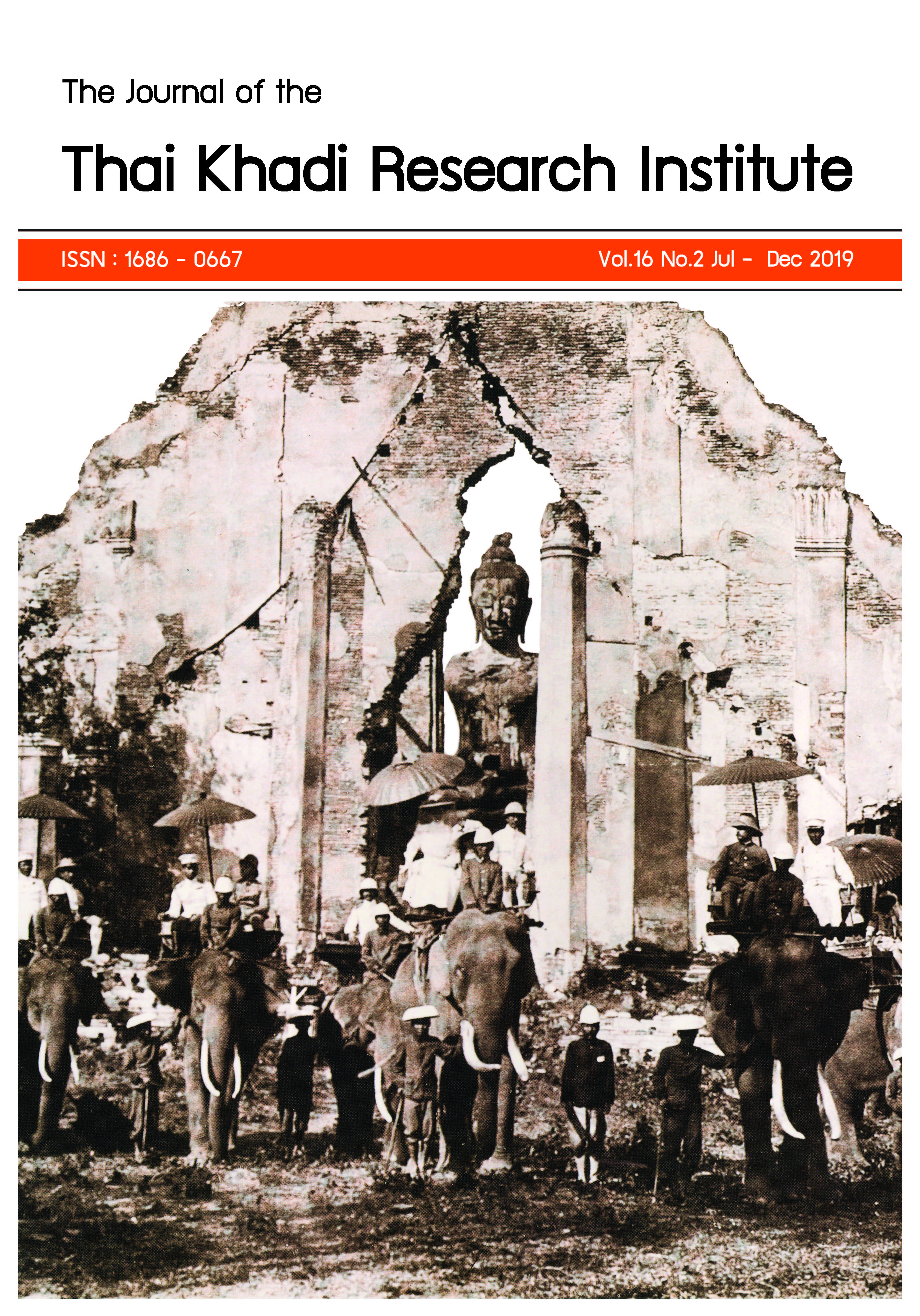วารสารไทยคดีศึกษา ปีที่ 16 ฉบับที่ 2 เล่มนี้ ประกอบด้วยบทความที่มีเนื้อหาหลากหลาย ได้แก่ งานศึกษาทางประวัติศาสตร์การรับรู้เกี่ยวกับกรุงศรีอยุธยาในสายตาของผู้คนยุคต้นรัตนโกสินทร์ งานประวัติศาสตร์ศิลปะว่าด้วยการกำหนดอายุเจดีย์พิจารณาผ่านอิทธิพลรูปแบบสถาปัตยกรรม งานศึกษาเชิงมานุษยวิทยาว่าด้วยการปรับเปลี่ยนอัตลักษณ์ของสัปเหร่อหรือ “คนเผาผี” ตลอดจนงานศึกษาการประเมินคุณค่าทุนทางวัฒนธรรมของวัด / โบราณสถานผ่านกรอบแนวคิด ICOMOS ไปจนถึงงานศึกษาในมิติเชิงนโยบายพิจารณาจากนโยบายการสื่อสารการท่องเที่ยวไทย จะเห็นได้ว่าสารัตถะที่ปรากฏในวารสารไทยคดีศึกษาฉบับนี้ สะท้อนการผลิตสร้างงานวิชาการในเชิงงานภาคสนามและวิธีวิทยาที่หลากหลาย ตลอดจนองค์ความรู้อันเกี่ยวเนื่องกับ “ไทยศึกษา” ที่ปรากฏในงานวิชาการร่วมสมัย
บทความแรก กรุงศรีอยุธยาในรัตนโกสินทร์ สมัยรัชกาลที่ 1 - 5: ศึกษาจากเอกสารวรรณคดีและเอกสารสมัยรัตนโกสินทร์ โดย นิชาภา ทิชากรสกุล เป็นการศึกษาโลกทัศน์การรับรู้เกี่ยวกับ “กรุงศรีอยุธยา” ของผู้คนและสังคมสมัยต้นรัตนโกสินทร์ ผ่านงานวรรณคดีและหลักฐานประเภทต่าง ๆ ข้อค้นพบคือ มุมมองของผู้คนสมัยต้นรัตนโกสินทร์ที่มีต่อพระนครศรีอยุธยา คือ ราชธานีเก่าที่ล่มสลายไปแล้ว โดยเฉพาะอย่างยิ่งในช่วงสามรัชกาลแรกสมัยรัตนโกสินทร์ที่เป็นช่วงสร้างบ้านแปงเมือง ความสนพระราชหฤทัยหลักของพระมหากษัตริย์จึงมุ่งเน้นไปที่การสร้างกรุงเทพฯ ราชธานีใหม่ให้มีความสวยงามและมั่นคงเป็นสำคัญ กระนั้นก็ตาม การรับรู้เกี่ยวกับกรุงศรีอยุธยาในทัศนะของกลุ่มชนชั้นนำไทยก็ปรากฏนัยที่แตกต่างซี่งอาจสะท้อนการเมืองภายในราชสำนัก โดยเฉพาะความขัดแย้งระหว่าง “วังหลวง” กับ “วังหน้า” ในช่วงสมัยรัชกาลที่ 1 ครั้นราวสมัยรัชกาลที่ 3 กรุงศรีอยุธยามีความหมายถึงกรุงเทพฯ อันสะท้อนให้เห็นว่าในทัศนะของผู้คนยุคนั้นแม้อยุธยาจะล่มสลายไปแล้ว หากแต่พระนครที่สร้างขึ้นใหม่ก็วิจิตรโอฬารเทียบเท่าเป็นความยิ่งใหญ่ที่ทดแทนกรุงศรีอยุธยาเดิม ครั้นถึงสมัยรัชกาลที่ 4 การรับรู้เกี่ยวกับกรุงศรีอยุธยา คือ เมืองเก่าอันเป็นรากเหง้าแห่งสยามประเทศ ที่พระมหากษัตริย์ทรงให้ความสำคัญกับการกลับไปบูรณปฏิสังขรณ์ ทั้งนี้ สาเหตุสำคัญอาจเป็นผลมาจากลัทธิล่าอาณานิคมของตะวันตก โดยรัชกาลที่ 4 ทรงต้องการใช้พระนครศรีอยุธยาเป็นเครื่องมือแสดงให้ตะวันตกเห็นถึงประวัติศาสตร์ความเป็นมาและความเจริญรุ่งเรืองที่ยาวนานของประเทศสยาม และอาจยังต้องการแสดงถึงความเกี่ยวพันระหว่างราชวงศ์สมัยอยุธยากับราชวงศ์จักรีที่ตั้งขึ้นใหม่
ต่อเนื่องด้วย บทความ เจดีย์วัดหัวข่วงเมืองแพร่: การศึกษาประวัติศาสตร์และรูปแบบสถาปัตยกรรม โดย นันทพร พุ่มมณี ที่ชี้ให้เห็นว่าแม้วัดหัวข่วงจะเป็นวัดสำคัญที่มีปรากฏแทบทุกเมืองใหญ่ในอาณาจักรล้านนา (ภาคเหนือของไทย) อีกทั้งมักมีพิกัดที่ตั้งของวัดที่คาดคะเนได้ว่ามักอยู่บริเวณทิศเหนือของข่วงเมืองหรือกลางเมือง กระนั้นก็ตาม ด้านรูปแบบทางด้านสถาปัตยกรรมของเจดีย์วัดหัวข่วงในแต่ละพื้นที่หรือแต่ละเมืองกลับไม่มีรูปแบบที่ชัดเจนตายตัว ดังจะพบความหลากหลายด้านสถาปัตยกรรม ที่ขึ้นอยู่กับความนิยมของท้องถิ่นและอิทธิพลศิลปะที่ได้รับในขณะนั้น เช่น เจดีย์วัดหัวข่วงที่เมืองเชียงใหม่ที่เป็นรูปทรงระฆังบนฐานผังแปดเหลี่ยม เจดีย์วัดหัวข่วงบางแห่งเป็นทรงปราสาทยอด เช่น ที่เมืองลำปางและน่าน ขณะที่บางแห่งเป็นรูปทรงศิลปะพม่า เช่น วัดหัวข่วงที่ลำพูน กรณีเจดีย์วัดหัวข่วงเมืองแพร่พบว่ามีรูปแบบสถาปัตยกรรมเป็นเจดีย์ทรงระฆังกลมแบบล้านนา ส่วนรองรับองค์ระฆังเป็นชุดฐานบัวซ้อนกัน 3 ฐาน ในผังกลม ซึ่งพัฒนาจากสายวิวัฒนาการพระธาตุหริภุญชัย จังหวัดลำพูน มีอายุอยู่ในช่วงปลายพุทธศตวรรษที่ 21 ถึงต้นพุทธศตวรรษที่ 22 สิ่งนี้สอดคล้องกับพัฒนาการเจดีย์ทรงระฆังล้านนาอย่างแท้จริง คือ พระธาตุหริภุญชัย เมืองลำพูน ที่เชื่อว่ารูปแบบปัจจุบันเกิดขึ้นจากการซ่อมแซมครั้งใหญ่ในสมัยพระเจ้าติโลกราช แห่งราชวงศ์มังราย ในช่วงปลายพุทธศตวรรษที่ 20 ประเด็นดังกล่าวยังสัมพันธ์กับประวัติศาสตร์ล้านนาในยุคที่เชียงใหม่-ลำพูน (ราชวงศ์มังราย) ขยายอิทธิพลสู่เมืองแพร่ในสมัยพระเจ้าติโลกราช ซึ่งทำให้แพร่กลายเป็นส่วนหนึ่งของล้านนา ทั้งนี้ เจดีย์วัดหัวข่วงนี้นับเป็นจุดเริ่มต้นของการรับอิทธิพลรูปแบบสถาปัตยกรรมล้านนาและส่งอิทธิพลให้กับเจดีย์อื่น ๆ ในเมืองแพร่อีกด้วย
บทความ การเปลี่ยนแปลงอัตลักษณ์ “คนเผาผี” ในเขตชุมชนเมืองนครศรีธรรมราช โดย ดำรงพันธ์ ใจห้าววีระพงศ์, เก็ตถวา บุญปราการ และ ณฐพงศ์ จิตรนิรัตน์ เป็นมิติงานมานุษยวิทยาที่ศึกษา “การเมืองอัตลักษณ์” (Identity Politics) ของกลุ่มคนตัวเล็กตัวน้อย ผู้ด้อยกว่าภายใต้โครงสร้างความสัมพันธ์เชิงอำนาจ (Subaltern) ซึ่งในการศึกษานี้คือ “คนเผาผี” หรือ สัปเหร่อ ผลการศึกษาพบว่า อัตลักษณ์ของ “คนเผาผี” มีความเปลี่ยนแปลงไปตามบริบททางเศรษฐกิจสังคม กล่าวคือ คนเผาผียุคแรกเริ่มหรือยุคเชิงตะกอน จะมีอัตลักษณ์คนชั้นต่ำ น่ากลัว กินข้าววัด นอนศาลา ได้เมียหมา ห่มผ้าผี เจ้าคาถา / เจ้าพิธี ฯลฯ อย่างไรก็ตาม อัตลักษณ์ของ “คนเผาผี” มีการปรับเปลี่ยนเรื่อยมาภายใต้กระบวนการต่อสู้ต่อรองเพื่อปรับเปลี่ยนความสัมพันธ์เชิงอำนาจ หรือ มิติ “การเมืองอัตลักษณ์” ทั้งนี้ ณ ปัจจุบัน อัตลักษณ์ “คนเผาผี” ถูกนำเสนอในทางมิใช่อาชีพน่ากลัว ต่ำต้อย ทั้งยังปรากฏอัตลักษณ์ใหม่ที่ “คนเผาผี” ใส่สูทเผาศพ มีทักษะสูงในเรื่องการจัดการบริหารงานศพทุกขั้นตอนมีความเป็นมืออาชีพในฐานะผู้ให้บริการลูกค้า คนเผาผียุคใหม่ยังใช้ Facebook หรือ Line ในการสื่อสารรับงาน กระนั้นก็ตาม แม้จะมีอัตลักษณ์ความทันสมัย หากแต่พวกเขาก็ยังใส่ใจเคร่งครัดในธรรมเนียมปฏิบัติ ทั้งคงความเป็นเจ้าคาถา / เจ้าพิธี ที่ยังคงความเป็นอัตลักษณ์สำคัญของ “คนเผาผี”
สำหรับบทความ วัดคงคาราม จังหวัดราชบุรี: คุณค่าของทุนทางวัฒนธรรมที่จับต้องได้ และแนวทางส่งเสริมเป็นแหล่งเรียนรู้วัฒนธรรมชาวมอญในประเทศไทย โดย สิโรตม์ ภินันท์รัชต์ธร เป็นงานศึกษาทุนทางวัฒนธรรมที่จับต้องได้ (Tangible culture) ที่ประยุกต์ใช้แนวคิดของ ICOMOS ในการประเมินคุณค่าของทุนทางวัฒนธรรมที่จับต้องได้ ผ่านมิติคุณค่า 4 ด้าน ได้แก่ 1) คุณค่าด้านประวัติศาสตร์ (Historic value) 2) คุณค่าด้านสุนทรียภาพ (Aesthetic value) 3) คุณค่าด้านวิชาการ (Scientific value) และ 4) คุณค่าด้านสังคม (Social value) ผลการศึกษาพบว่า วัดคงคาราม จังหวัดราชบุรี เป็นวัดศูนย์กลางชุมชนขนาดใหญ่ของชาวมอญในจังหวัดราชบุรีมาตั้งแต่สมัยต้นกรุงรัตนโกสินทร์ ภายในวัดปรากฏงานศิลปกรรมที่เกี่ยวเนื่องกับวัฒนธรรมของชาวมอญอยู่เป็นจำนวนมาก อาทิ เจดีย์แบบมอญ จิตรกรรมในพระอุโบสถ จิตรกรรมในศาลาการเปรียญ กุฏิเรือนไทย 9 ห้อง พิพิธภัณฑ์พื้นบ้านชาวมอญ เป็นต้น สิ่งเหล่านี้ล้วนเป็นทุนทางวัฒนธรรมที่จับต้องได้ ที่มีคุณค่าทั้งในด้านประวัติศาสตร์ สุนทรียภาพ วิชาการ และสังคม ซึ่งเป็นองค์ความรู้ที่มีศักยภาพ อันสามารถนำไปส่งเสริมให้วัดคงคารามเป็นแหล่งเรียนรู้ด้านศิลปะและวัฒนธรรมของชาวมอญในประเทศไทย ด้วยแนวความคิดทางด้านประวัติศาสตร์ศิลปะที่มุ่งสร้างความรู้ความเข้าใจบนพื้นฐานของความเป็นวิชาการ
ท้ายสุดคือบทความ นโยบายการสื่อสารการท่องเที่ยววิถีไทยและการปรับตัวของชุมชนในจังหวัดพังงาและจังหวัดตรัง โดย กวิน สิงห์อินทร์ ที่ให้ภาพนโยบายด้านการสื่อสารของการท่องเที่ยวแห่งประเทศไทย (ททท.) ภายใต้นโยบายท่องเที่ยววิถีไทย ซึ่งถูกประกาศเป็นวาระแห่งชาติตั้งแต่ พ.ศ. 2558 โดยเป็นนโยบายที่กำหนดขึ้นโดยรัฐบาลเพื่อมุ่งส่งเสริมการท่องเที่ยวเชิงคุณภาพ และนำเสนอความเป็นไทยให้เป็นจุดขายทางการท่องเที่ยวเพื่อให้เกิดรายได้ทางการท่องเที่ยว ตลอดจนสร้างชุมชนให้เข้มแข็งด้วยการกระจายรายได้สู่ชุมชนและท้องถิ่น นโยบายท่องเที่ยววิถีไทยยังอยู่ภายใต้กรอบคิดเรื่อง “ไทยแลนด์ 4.0” ที่มุ่งหวังสร้าง “ท่องเที่ยว 4.0” มุ่งเน้นการขับเคลื่อนเศรษฐกิจการท่องเที่ยวฐานรากพัฒนาสินค้าการท่องเที่ยวให้มีนวัตกรรม สำหรับชุมชนการท่องเที่ยวที่ถูกคัดเลือกให้เข้าโครงการในกรณีจังหวัดพังงา และจังหวัดตรัง “วิถีไทย” ได้ถูกขับเน้นไปที่เรื่อง “ชุมชนเมืองเก่า” และ “ชุมชนประมงพื้นบ้าน” ซึ่งพบว่ามีความพยายามปรับตัวเพื่อการท่องเที่ยว อาทิ การรื้อฟื้นวัฒนธรรมบาบ๋า รื้อฟื้นการแต่งกาย วัฒนธรรมการกินอยู่เพื่อให้เข้ากับบรรยากาศ “โหยหาอดีต” กรณีชุมชนประมงพื้นบ้านที่มีวิถีชีวิตเป็นชุมชนมุสลิม พบว่ามีการเปิดบ้านเป็นโฮมสเตย์ตลอดจนการนำวัฒนธรรมมุสลิมมาทำเป็นกิจกรรมการท่องเที่ยว อย่างไรก็ตาม หากพิจารณาในประเด็นการสื่อสารการท่องเที่ยว อาจกล่าวได้ว่านโยบายท่องเที่ยววิถีไทย โดยแท้จริงแล้ว มีลักษณะ Top-down เป็นอย่างมาก อีกทั้งมิได้เน้นการมีส่วนร่วมของประชาคมชุมชนในท้องที่อย่างที่ควรจะเป็น
วารสารไทยคดีศึกษาฉบับนี้ยังมี บทวิจารณ์หนังสือ จดหมายเหตุฟอร์บัง (Memories du comte de Forbin, Chef D' Escarde, Chevalier de L'Ordre Melitaire de Sainte Louis) โดย Chevalier de Forbin ผู้แปล มจ.ดำรัสดำรง เทวกุล วิจารณ์โดย ดวงรักษ์ จันแตง รวมถึงแนะนำหนังสือ “สืบสานจิตรกรรมไทยในพม่า” ณ อุโบสถวัดมหาเตงดอจี และ เจติยวิหารจอกตอจี แนะนำโดย สิโรตม์ ภินันท์รัชต์ธร และหนังสือ กระบวนพยุหยาตราชลมารค เนื่องในการเสด็จพระราชดำเนินเลียบ พระนคร ในพระราชพิธีบรมราชาภิเษก พุทธศักราช 2562 แนะนำโดย อาสา คำภา อันเป็นผลงานที่นักวิจัยและคณะทำงานสถาบันไทยคดีศึกษา ผลิตขึ้นในช่วงครึ่งหลัง พ.ศ. 2562 นี้ นอกจากนี้ เนื้อหายังมีข่าวกิจกรรมวิชาการและศิลปวัฒนธรรม ที่ สถาบันไทยคดีศึกษา จัดขึ้นในช่วงเดือนมิถุนายน - ตุลาคม พ.ศ. 2562 ซึ่งกองบรรณาธิการได้รวบรวมและสรุปสาระสำคัญของกิจกรรมเหล่านี้ไว้ด้วย
สุดท้ายนี้ กองบรรณาธิการหวังว่า วารสารไทยคดีศึกษาจะเป็นเวทีและสื่อกลางในการเผยแพร่แลกเปลี่ยนองค์ความรู้ด้าน “ไทยศึกษา” ที่สามารถตอบโจทย์ในด้านวิชาการและเป็นคุณูปการในทางสังคม อีกทั้งเป็นวารสารทางวิชาการที่ผู้สนใจให้การสนับสนุนต่อไป
เผยแพร่แล้ว: 2019-12-18


